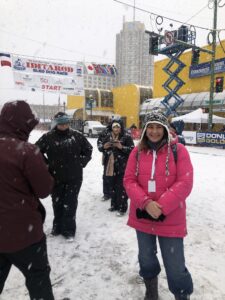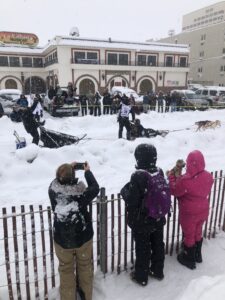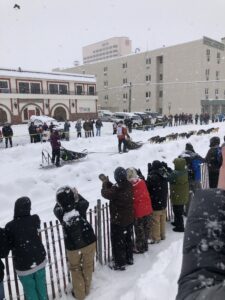Stepping outside to the start of the 50th Anniversary 2022 Iditarod Dog Sled Race was like walking into a snow globe. Giant powdery flakes fell heavily from the sky, turning downtown Anchorage into a winter wonderland.  The perfect atmosphere for the Iditarod! As we wandered around 4th Avenue a plan began to form for how to view the ceremonial start. Once things kick off, teams go every two minutes. This year, coincidentally, there are 50 mushers running the 50th anniversary Iditarod! Not wanting to miss a thing, we decided to divide and conquer all the spots that had been recommended to us; we scouted out ten mushers mid-way down 4th, ten mushers at the turn onto Cordova, ten mushers at the start, and ten mushers from the upper floors of the parking garage, giving us a ten musher flexibility for travel time. Each location had remarkable views and provided a unique perspective.
The perfect atmosphere for the Iditarod! As we wandered around 4th Avenue a plan began to form for how to view the ceremonial start. Once things kick off, teams go every two minutes. This year, coincidentally, there are 50 mushers running the 50th anniversary Iditarod! Not wanting to miss a thing, we decided to divide and conquer all the spots that had been recommended to us; we scouted out ten mushers mid-way down 4th, ten mushers at the turn onto Cordova, ten mushers at the start, and ten mushers from the upper floors of the parking garage, giving us a ten musher flexibility for travel time. Each location had remarkable views and provided a unique perspective.
On 4th Avenue we saw the Denali Park Patrol sled dogs get a little confused and it took them a moment to figure out the trail. We also saw Matt Failor head out in bib number 10, wife Liz riding on the sled behind him, and we cheered them on enthusiastically! Karin Hendrickson and her team, who we spent time with at Iditarod Headquarters vet check, were ready at the start to make the run to Nome. From the parking garage we looked down over 4th Avenue, watching the last of the mushers leave the start and enjoying the view from above the trail.
All of these places provided an incredible opportunity to experience the ceremonial start. However, I must admit that as a teacher I loved watching the mushers take the corner from 4th Avenue onto Cordova Street. This is a hard right turn and the dogs tend to take it a little tight, which can cause some serious tumbles for the mushers, their Iditarider, or their handler on the second sled. I watched some mushers take it smooth and easy, while others had epic wipe-outs. I saw so many ways to use this as a teaching tool for social-emotional learning and encouraging a growth mindset.
One of the biggest challenges at the turn is the second sled. The ceremonial start is a relatively low-key ride. Mushers take it slow and gentle to give the crowd a good show and the Iditarider (a person who gets the honor of being in the sled for the trip to Campbell) a positive experience. In order to do this they need to slow the dogs down, and this is done by having them drag a second sled with one of their handlers on board. I heard Ryan Redington, mushing royalty, call back to his sled handler just after the turn, “That’s the hardest part, we’re good now”. We all know he wasn’t referring to the actual race, just the 11 mile trek to Campbell Airstrip. But once a musher clears the turn they can relax and enjoy the ride.
So what did we see? Mushers who cleared the turn without blinking. Mushers and handlers who had to balance and cut it close. Mushers who tipped, including an Iditarider who was dragged on their side for several meters. Handlers who crashed into the snow bank and flew off the sled. Trail guides at the corner who threw their entire body onto a sled to stop it from getting away from a musher who had fallen off. Each time the guides yelled “DOGTEAM” you knew it would be a different turn and a different result.
The more experienced mushers seemed to have an easier time. Did the rookie musher that wiped out give up? Nope. Maybe they can’t make the turn onto Cordova – YET – but it doesn’t mean they won’t keep trying. The concept of the team, musher, Iditarider, and handler reminded me of a classroom trying to tackle a new task. You will have your lead dogs pulling out front; those who get the concept and want to keep going. You’ll have those on the second sled, barely keeping up and maybe falling off; kids that need more support and practice. As a class we all need to make the turn onto Cordova. We can’t leave anyone behind. The mushers can’t do that. I watched 5-time winner Dallas Seavey take the entire turn looking backwards to make sure his handler was with him. The handler celebrated as Seavey gave him a thumbs-up when they were all clear.
Check out this video of Aaron Burmeister taking the turn. When his handler wipes out the trail guides jump in to slow the sled and Burmeister cheers “Come on! Let’s go!” The dogs can’t keep going without the musher, the musher can’t keep going without the 2nd sled. They need to make this journey together.
In life and in the classroom we do not take our journey alone. When we get to a tough turn and fall off we all need someone to jump on the sled and stop it so we can get back on. We need someone checking to make sure we are still there, and someone encouraging us to get back up and try again.
Teachers: Using the Iditarod in the classroom can be done in many ways – today there were countless examples of teaching measurement and time – but consider integrating it into your social emotional check-ins or comprehension checks. Show your students videos of mushers taking the turn onto Cordova. Do you understand the new content? You are a lead dog! Did you notice someone else struggling, or can you help a classmate? Musher! Are you unsure? Maybe you are a balancing musher just getting by but not fully grasping the topic. Confused? Trail Guide jumping on the sled to slow it down until you can get back on. Completely perplexed? You wiped out at Cordova and need help getting back on track. Part of teaching with the Iditarod is to incorporate the race into all areas throughout the year, not just one unit or lesson. “Taking the Turn” can be an entire classroom philosophy or theme to support all areas of student engagement.





